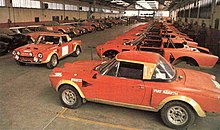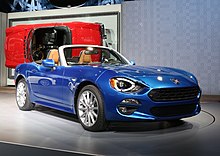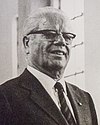Fiat 124 Sport Spider
| Fiat 124 Sport Spider | |
|---|---|
 Fiat 124 Sport Spider (CS) | |
| Overview | |
| Manufacturer | Fiat1966–1981 Pininfarina1981–1985 |
| Also called | Fiat Spider 2000[1] Pininfarina Spider (1983–1985) |
| Production | 1966–1985 |
| Assembly | Turin,Italy San Giorgio Canavese,Italy (Pininfarina) |
| Designer |
|
| Body and chassis | |
| Class | Sports car |
| Body style | 2-doorcabriolet |
| Layout | Front-engine, rear-wheel-drive |
| Related | Fiat 124 |
| Powertrain | |
| Engine | |
| Transmission | |
| Dimensions | |
| Wheelbase | 89.75 in (2,280 mm)[3] |
| Length | 156.25 in (3,969 mm)[3] |
| Width | 63.5 in (1,613 mm)[3] |
| Height | 49.25 in (1,251 mm)[3] |
| Chronology | |
| Predecessor | Fiat Pininfarina Cabriolet |
| Successor | Fiat Barchetta Fiat 124 Spider (2016)(Spiritual) |
TheFiat 124 Sport Spideris aconvertiblesports car marketed byFiatfor model years 1966–1985. Designed by and manufactured at the ItaliancarrozzeriaPininfarinafactory, themonocoque,front-engined, rear-drive Sport Spider debuted at the November 1966Turin Auto Showwith styling byTom Tjaarda.
Fiat later marketed the car as theSpider 2000(1979–1982). After being retired by Fiat, Pininfarina continued the production of the model under its own brand asPininfarina Spider Azzurrafor the North American market andPininfarina Spidereuropafor the European market for three more years, from August 1982 until 1985.[4]
In 2015, asuccessorof the Fiat 124 Spider was presented at theLos Angeles Auto Show.[5]
Development
[edit]


The Fiat 124 Sport Spider was designed by Pininfarina and styled in-house by Tom Tjaarda.[6]The 124 Sport Spider,124 Sport Coupéand124 sedanshare much of their running gear, and in the case of the coupé,platforms.The Sports Spider uses a shorter platform along with a shorterwheelbase,and in contrast to the Pininfarina-styled and manufactured spider, Fiat designed and manufactured the coupé in-house.
The succession of build series of the 124 were designated internally as AS, BS, BS1, CS, and CSA. AS models had a torque tube transmitting power to the rear wheels; this crack-prone design was replaced by a trailing-arm rear axle with the second series (BS) during 1969, which was manufactured alongside the AS for the first six months of 1970. The early AS cars also have smaller taillights, while the BS received a mesh grille and black-rimmed gauges inside. In July 1970, the 1.6-liter BS1 appeared; this model is recognizable by its twin humps on the bonnet and bumper overriders. The CS series Spider arrived during 1972. Also in 1972, a sports version of the Spider debuted, required for type-approval of its rally version, and was marketed as 124 CSA (C-Spider-Abarth). The vehicle has a capacity of 128 hp (94 kW). In three years, Fiat manufactured less than 1000 CSA models, which were intended for sale to individual clients.
The car was manufactured by Fiat (with a Pininfarina body) in Turin until October 1981, when Pininfarina took over manufacture in theirSan Giorgio Canaveseplant. Serial numbers started over from zero, while the 11th digit in thevehicle identification numberwas switched from an 8 to a 5. The Fiat Spider 2000 ended manufacture in July 1982, and after the Italiansummer holidays,production of Pininfarina-badged cars commenced in its place.
Specifications
[edit]Engines
[edit]Thefour-cylinder engineused in thespiderandcoupéis adouble overhead cam,aluminumcrossflowhead version of the sedan's pushrod unit. It started in 1966 with a capacity of 1438 cc, progressively increasing to 1608 cc in 1970 (although this was reduced to 1,592 cc in 1973), 1,756 cc in 1974, and finally 1,995 cc in 1979. TheFiat Twin Cam enginewas designed by ex-FerrariengineerAurelio Lampredi.Bosch fuel injection replaced the previously used Weber carburetors midway through 1980. In 1981 and 1982, Fiat USA, Inc. partnered with Legend Industries to create around 700 turbo models for US markets. A supercharged model called "Volumex" also was offered toward the end of production; it was sold only in Europe, where it cost 35% more than a regular, fuel-injected Spidereuropa.[a]This family of engines remained in production into the 1990s, giving it one of the longest production runs in automotive history. The double overhead cam (DOHC) version of the engine was the first mass manufactured DOHC to use reinforced-rubber timing belts, an innovation that came into nearly universal use in the decades after its introduction. Its derivatives powered race cars such as the Fiat 131 Mirafiori, 124 Special T, Lancia Beta Montecarlo, Delta Integrale, and many others.
| Years | Model | Engine | Capacity | Bore x stroke mm |
Compr. ratio |
Power at engine speed |
|---|---|---|---|---|---|---|
| 1967–73 | 124 AC 040 | 1,438 cc | 80 x 71.5 mm | 8.9:1 | 90PS(66kW;89hp) at 6,000 rpm | |
| 1973–77 | 132 AC 000 | 1,592 cc | 80 x 79.2 mm | 9.8:1 | 108 PS (79 kW; 107 hp) at 6,000 rpm | |
| 1973–75 | Abarth Rally | 132 AC 4.000 | 1,756 cc | 84 x 79.2 mm | 9.8:1 | 128 PS (94 kW; 126 hp) at 6,200 rpm |
| 1970–73 | 125 BC 000 | 1,608 cc | 80 x 80 mm | 9.8:1 | 110 PS (81 kW; 108 hp) at 6,400 rpm | |
| 1973–77 | 132 AC1 000 | 1,756 cc | 84 x 79.2 mm | 9.8:1 | 118 PS (87 kW; 116 hp) at 6,000 rpm | |
| 1974–78 | 132 A1 040 | 1,756 cc | 84 x 79.2 mm | 8.9:1 | 118 PS (87 kW; 116 hp) at 5,800 rpm | |
| 1974–78 | 131 A1 040 | 1,756 cc | 84 x 79.2 mm | 8.1:1 | 87 PS (64 kW; 86 hp) at 6,200 rpm | |
| 1979–81 | 132 C2 040 | 1,995 cc | 84 x 90 mm | 8.1:1 | 83 PS (61 kW; 82 hp) at 5,800 rpm | |
| 1979–85 | 132 C3 031 | 1,995 cc | 84 x 90 mm | 8.2:1 | 102 PS (75 kW; 101 hp) at 5,500 rpm | |
| 1979–85 | Spidereuropa | 132 C3 031 | 1,995 cc | 84 x 90 mm | 8.2:1 | 105 PS (77 kW; 104 hp) at 5,500 rpm |
| 1984–85 | Volumex | 132 V3 031 | 1,995 cc | 84 x 90 mm | 7.5:1 | 135 PS (99 kW; 133 hp) at 6,000 rpm |
Suspension
[edit]Suspension is conventional by unequal-length wishbones and coilover damper at the front and by coil-spring live rear axle at the rear, which is located by a transverse link (Panhard rod) and two pairs of forward-extending radius rods to react to braking and acceleration forces, and to control axle wind-up.
Models
[edit]North American model
[edit]
The coupé and Spider were marketed in Canada and the US beginning in 1968. In 1969, the Spider featured four-wheel disc brakes, double overhead cams, hesitation wipers, steering column-mounted lighting controls, radial-ply tyres, and a five-speedmanual transmission.An optional three-speedautomatic transmissionfrom General Motors was available from 1979 through 1985 for North America and Japan. The Spider's convertible top was known for its simplicity of use—allowing a seated driver to quickly raise or lower the top.[8]When the engine was upgraded to 2.0 L, the model was renamed the Fiat 2000 Spider. For the 1980 model year, a version with a catalytic converter andBoschL-Jetronic fuel injection was introduced for California and optional in the other 49 states. For 1981, this engine, with 102 hp (76 kW), became standard fitment in North America.[8]
Fiat subsequently stopped marketing the Spider and theX1/9—to have their marketing assumed by their respectivecarrozzerie.[4]In Europe, theRitmo Cabriowas also marketed byBertonerather than Fiat itself.[9]In the US, Fiat turned over marketing and support of the Spider and theX1/9to International Automobile Importers, Inc., headed byMalcolm Bricklin.
Fiat Abarth 124 Rally
[edit]| Fiat Abarth 124 Rally | |
|---|---|
 | |
| Body and chassis | |
| Body style | 2-door spider with fixedhardtop |
| Chronology | |
| Successor | Fiat Abarth 131 Rally |
The Fiat Abarth 124 Rally is a homologated version of the 124 Sport Spider, known also as "124 Abarth Stradale", introduced in November 1972.[10][11] It receivedFédération Internationale de l'Automobilehomologationin thespecial grand touring cars (group 4)racing class, and replaced the 1.6-litre Fiat Sport Spider rally cars, which were then being campaigned. At the time, 124 had already won the 1972European Rally Championshipat the hands ofRaffaele Pintoand Gino Macaluso.[10] The 124 Rally was added to the Sport Spider range, which included the 1600 and 1800 models; the first 500 examples produced were earmarked for the domestic Italian market.[11]
Amongst the most notable modifications over the standard Spider wereindependent rear suspension,engine upgrades, lightweight body panels, and a rigidhard top.
In place of the usual rearsolid axle,independent suspension from lower wishbones is used, with the original trailing arms, an upperstrut,and an antiroll bar. At the front, aradius rodon each side was added to the standard double wishbones.
The Abarth-tuned type 132 AC 4.000 1.8-litre, twin-cam engine was brought from the standard 118 to 128 PSDIN(94 kW; 126 hp)[12]by replacing the standard twin-chokecarburettorwith double vertical twin-chokeWeber44 IDFs, and by fitting an Abarth exhaust with a dual exit muffler.[10][11]The 9.8:1 compression ratio was left unchanged.[11]
The transmission is the all-synchronised five-speed optional on the other Sport Spider models, and brakes arediscson all four corners. Despite the 20 kg (44 lb) four-pointroll barfitted,kerb weightis 938 kg (2,068 lb), roughly 25 kg (55 lb) less than the regular 1.8-litre Sport Spider.[10]
The engine bonnet, boot lid, and fixed hard top arefibreglass,painted matt black; the rear window isperspexand the doors are aluminium. Front and rear bumpers were deleted and replaced by simple rubber bumperettes. A single matte-blackwing mirrorwas fitted. Matte-black wheel-arch extensions house185/70 VR 13PirelliCN 36 tyres on5.5 J × 13 "four-spokealloy wheels.[10] Inside, thecentre console,rear occasional seats, and glovebox lid were eliminated; its new features were anodised aluminium dashboard trim, a small, three-spoke, leather-covered Abarthsteering wheel,andRecarocorduroy-and-leatherbucket seatsas an extra-cost option.[10] The car carries Fiat badging front and rear, Abarth badges, and "Fiat Abarth" scripts on thefront wings,and Abarth wheel-centre caps. Only three paint colours were available: Corsa red, white, and light blue.[10]
| Fiat Abarth 124 Rally, specifications and comparison[10][12] | |||
|---|---|---|---|
| Fiat Abarth 124 Rally | Fiat 124 Sport Spider 1800 | ||
| Engine | 1,756 ccDOHCinline-four | ||
| Carburettors | 2x twin-choke Weber 44 IDF | 1x twin-choke Weber 34 DMS | |
| Power | 128 PS DIN (94 kW; 126 hp) at 6,200 rpm | 118 PS DIN (87 kW; 116 hp) at 6,000 rpm | |
| Torque | 16.2 kg⋅m (159 N⋅m; 117 lb⋅ft) at 5,200 rpm | 15.6 kg⋅m (153 N⋅m; 113 lb⋅ft) at 4,000 rpm | |
| Wheelbase | 2,280 mm (89.8 in) | 2,280 mm (89.8 in) | |
| Length | 3,914 mm (154.1 in) | 3,971 mm (156.3 in) | |
| Width | 1,630 mm (64.2 in) | 1,613 mm (63.5 in) | |
| Track front–rear |
1,413–1,400 mm (55.6–55.1 in) | 1,346–1,316 mm (53.0–51.8 in) | |
| Kerb weight incl. 75 kg driver[13] |
938 kg (2,068 lb) | 960 kg (2,116 lb) | |
| Top speed | over 190 km/h (118 mph) | 185 km/h (115 mph) | |
Rallying
[edit]

In 1971, the 124 Spider was prepared for theInternational Championship for Manufacturerswhen Abarth became involved with its production and development. Abarth designer Ing. Colucci was responsible for getting the 124 Spider intoGroup 4rally trim. Over this period, the Abarth Spider was relatively successful with wins at the 1972 Hessen Rally,Acropolis Rally,1973 Polish Rally, 19th on the 1973 RAC rally, and seventh to mostly the Alpine Renaults on the1973 Monte Carlo Rally.The Spider continued to perform with first, second, and third in the 1974 eighth Portuguese TAP Rally, sixth in the1974 1000 Lakes Rally,fourth in the 1975 Monte Carlo Rally, and also withMarkku Aléndriving the spider to third place. By 1976, the days of 124 rallying were numbered due to the appearance of the Fiat-Abarth 131.[14]
Production
[edit]The Spider was sold from 1966 for European and US markets, but from 1975 until 1981, they were produced only for the US market. In 1981, they were reintroduced in Europe until the end of production in 1985. Almost 200,000 Spiders had been manufactured, with 75% for the US market. The nine models of the spider are the AS, BS, BS1, CS, CSA (Abarth), CS1, CS2, CS0, and DS.
| Year | Model | Starting chassis no. | Displacement | Engine type | Fuel delivery | Aspiration |
|---|---|---|---|---|---|---|
| 1966 | AS | 000001 | 1438 | 124 AC.040 | Carbureted | Naturally |
| 1967 | AS | 1438 | 124 AC.040 | Carbureted | Naturally | |
| 1968 | AS | 0005619 | 1438 | 124 AC.040 | Carbureted | Naturally |
| 1969 | AS | 0010554 | 1438 | 124 AC.040 | Carbureted | Naturally |
| 1970 | BS | 0021861 | 1438 | 124 AC.040 | Carbureted | Naturally |
| 1971 | BS | 22589 | 1438 | 124 AC.040 | Carbureted | Naturally |
| 1971 | BS1 | 33950 | 1608 | 125BC.040 | Carbureted | Naturally |
| 1972 | BS1 | 47032 | 1608 | 125BC.040 | Carbureted | Naturally |
| 1973 | CS | 59592 | 1608 | 125BC.040 | Carbureted | Naturally |
| 1973 | CS1 | 63308 | 1592 | 132 AC.040.3 | Carbureted | Naturally |
| 1974 | CS1 | 71650 | 1756 | 132 A1.040.4 | Carbureted | Naturally |
| 1975 | CS | 88792 | 1756 | 132 A1.040.5 | Carbureted | Naturally |
| 1975 | CS | 88792 | 1756 | 132 A1.031.5 US market | Carbureted | Naturally |
| 1976 | CS1 | 99909 | 1756 | 132 A1.040.5 | Carbureted | Naturally |
| 1976 | CS1 | 99909 | 1756 | 132 A1.031.5 US market | Carbureted | Naturally |
| 1977 | CS | 113343 | 1756 | 132 A1.040.5 | Carbureted | Naturally |
| 1977 | CS | 113343 | 1756 | 132 A1.031.5 US market | Carbureted | Naturally |
| 1978 | CS | 126001 | 1756 | 132 A1.040.5 | Carbureted | Naturally |
| 1978 | CS | 126001 | 1756 | 132 A1.031.5 US market | Carbureted | Naturally |
| 1979 | CS2 | 142514 | 1995 | 132 CS2.040 | Carbureted | Naturally |
| 1979 | CS2 | 142514 | 1995 | 132 CS2.031 US market | Carbureted | Naturally |
| 1980 | CS0 | 00171001 | 1995 | 132 C3.031 | Fuel Injected | Naturally |
| 1980 | CS0 | 1938507 | 1995 | 132 C3.031 | Carbureted | Naturally |
| 1980 | CS2 | 0157654 | 1995 | 132 C3.040 | Carbureted | Naturally |
| 1981 | CS0 | 171001 | 1995 | 132 C3.031 | Fuel injected | Naturally |
| 1981 | CS2 | 164089 | 1995 | 132 C3.040 | Fuel injected | Turbocharged option |
| 1982 | CS2 | 1938507 | 1995 | 132 C3.040 | Fuel injected | Turbocharged option |
| 6/1982 | DS0 | 1967897 | 1995 | 132 C3.040 | Fuel injected | Naturally |
| 1983 | DS0 | 5500001 | 1995 | 132 C3.040 | Fuel injected | Naturally |
| 1984 | DS0 | 5503666 | 1995 | 132 C3.040 | Fuel injected | Naturally |
| 1985 | DS0 | 5506060 | 1995 | 132 C3.040 | Carbureted | Supercharged (Volumex) |
| Year | 1970 | 1971 | 1972 | 1973 | 1974 | 1975 | 1976 | 1977 | 1978 | 1979 | 1980 | 1981 | 1982 | 1983 | 1984 | 1985 | 1970–85 |
|---|---|---|---|---|---|---|---|---|---|---|---|---|---|---|---|---|---|
| Units made | 14,288 | 13,412 | 12,362 | 12,738 | 15,754 | 14,143 | 11,862 | 14,012 | 16,105 | 18,943 | 14,435 | 4,747 | 3,456 | 2,480 | 2,577 | 1,504 | 172,818 |
2016 model
[edit]
The 124 name was revived in 2016 through a joint venture with Mazda, using the newMazda MX-5platform. After considering possibly marketing the result as anAlfa Romeo Spider,the car was brought to the market as a Fiat. It was unveiled at theLos Angeles Auto Showin November 2015 and made available in late 2016.[16]The engine is a turbocharged 1.4MultiAirwith 160 hp (119 kW) from the Fiat range.
References
[edit]- ^Fiat Spider 2000 brochure, www.fiat500usa.comRetrieved 23 April 2018
- ^Tjaarda, Tom."Fiat 124 Spyder Design Story".spidersweb.nl.Retrieved16 May2013.
- ^abcdBensted-Smith, Richard (5 November 1966). "Sport-out of Fiat 124: The 124 spider; larger engine: twin overhead camshafts; Pininfarina 2+2 body".The Motor:25–27.
- ^abThe Concise 1966-78 FIAT 124 Spider, 1979-82 FIAT 2000 Spider & 1983-85 Pininfarina Spider History
- ^"Fiat 124 Spider revealed at 2015 LA Motor Show".Auto Express.Retrieved20 November2015.
- ^Thorson, Thor (May 2016). "1975 Fiat-Abarth 124 Sport Rally Group 4 Spider".Sports Car Market.28(5): 70–71.
- ^World Cars 1984.Pelham, NY: L'Editrice dell'Automobile LEA/Herald Books. 1984. p. 222.ISBN0-910714-16-9.
- ^abHogg, Tony (ed.). "1981 Buyer's Guide".Road & Track's Road Test Annual & Buyer's Guide 1981(January–February 1981): 96.
- ^World Cars 1984,p. 199
- ^abcdefgh"Fiat Abarth 124 Rally—La 124 R con la sospensione alla Chapman" [The 124 R with the Chapman-style suspension].Autosprint(in Italian).XII(47): 36–37. 20 November 1972.
- ^abcd"La" 124 Rally ", nuova sportiva".La Stampa(in Italian). 19 November 1972. p. 11.Retrieved21 July2015.
- ^abFiat Abarth 124 Rally—Uso e caratteristiche(owner's manual) (in Italian).Fiat.
- ^FIAT Factory Homologation Certificate
- ^Giacosa, John Tipler; foreword by Dante (1993).Fiat & Abarth 124 Spider & coupé.Godmanstone, England: Veloce Pub. Plc.ISBN1-874105-09-X.
{{cite book}}:CS1 maint: multiple names: authors list (link) - ^"Produzione complessiva"(PDF).pininfarina.it((Pininfarina production records)). Archived fromthe original(PDF)on 2011-06-05.Retrieved2007-08-03.
- ^Horncastle, Rowan (18 November 2015)."Meet Fiat's 124 Spider, Italy's MX-5-based answer to the MX-5".Top Gear.BBC Worldwide.Retrieved18 November2015.


